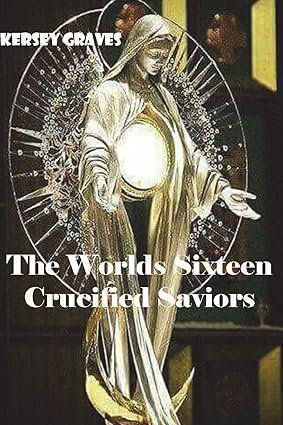
Introduction to the Concept of Crucified Saviors
The concept of crucified saviors is a recurring motif in various ancient religions and mythologies. Across different cultures and epochs, numerous deities or savior figures are depicted as undergoing crucifixion-like deaths. These narratives often pivot around themes of redemption, resurrection, or the subsequent betterment of humanity. The purpose of this exploration is to probe these parallels and examine the underlying significance of crucifixion in religious contexts.
Crucifixion, as a method of execution, is most famously associated with the crucifixion of Jesus Christ. However, it is crucial to recognize that this form of execution was practiced long before and beyond the Christian tradition. Ancient societies, particularly in the Mediterranean basin, employed crucifixion as a gruesome means of capital punishment. Consequently, its cultural and symbolic resonance found a place in the mythological frameworks of these societies.
This blog post elucidates upon the recurring character trope of the crucified savior – a phenomenon that transcends time and geography. By investigating various historical narratives and mythologies, one can discern that many religions have espoused similar portrayals of sacrificial figures. These figures often endure immense suffering, crucifixion in particular, to facilitate cosmic or societal redemption. This archetype evidences the profound human fascination with themes of sacrifice, martyrdom, and resurrection.
The recurrent appearance of crucified saviors across different civilizations hints at a shared subconscious or an intercultural transmission of ideas. Such figures are not mere victims; instead, they often embody divine will and purpose. Their suffering is not an end but a means to an exalted outcome, symbolizing hope and renewal for their adherents.
As we delve deeper into each case, one must consider the broader implications. These stories reflect collective aspirations and existential pondering, serving as powerful conduits for understanding human spirituality and the quest for redemption. By comparing these narratives, this blog aims to offer valuable insights into the universal human condition and the emblematic nexus of crucified saviors.
Historical Examples of Crucified Saviors
The concept of crucified saviors is not unique to Christianity; rather, it manifests across various ancient cultures, each embodying distinct narratives yet sharing striking commonalities. These stories often involve themes of divine sacrifice, resurrection, and salvation, indicating a pervasive motif of crucifixion throughout history.
One notable example is Horus of ancient Egypt. Horus, the falcon-headed god, revered in Egyptian myth, was claimed to have been crucified around 3,000 BCE. As per certain interpretations of Egyptian texts, Horus’s life and death included numerous miraculous events such as his birth to the virgin Isis and his resurrection, symbolizing eternal life after a symbolic crucifixion.
In the Indian context, Krishna stands as a parallel figure. Revered in Hindu mythology, Krishna’s life, particularly in the “Bhagavad Gita,” narrates divine birth, earthly struggles, and eventual martyrdom. Though not crucified in the literal sense, the tale of Krishna’s death by an arrow that struck his mortal frame carries echoes of the sacrificial death theme seen in other cultures.
Ancient Greece provides another fascinating instance with Dionysus, the god of wine and ecstasy. Dionysus’s mythology includes suffering and resurrection, akin to the crucifixion motif. While Dionysus may not have been crucified traditionally, he was subjected to brutal death and dismemberment, often reinterpreted as a death that led to rebirth, illustrating a similar narrative structure.
In examining these historical examples, it becomes evident that the motif of crucifixion is neither isolated nor exclusive. Each narrative, while unique in its cultural context, interweaves themes of sacrifice, death, and resurrection. This repeated motif of a crucified savior across ancient religions underscores a shared human fascination with the ideas of suffering and salvation, transcending geographical and cultural boundaries.
The Symbolism and Meaning Behind Crucifixion
Crucifixion, a harrowing form of execution, holds profound symbolic significance in various myths and religions throughout history. Its recurrence across different cultures suggests a broader, cross-cultural resonance that extends beyond mere punishment. At its core, crucifixion often embodies themes of sacrifice, redemption, the defeat of evil, and the promise of resurrection or eternal life.
One primary reason crucifixion became a prevalent motif is its stark portrayal of sacrifice. In many ancient beliefs, individuals subjected to crucifixion were depicted as making the ultimate sacrifice for a greater good. This act of laying down one’s life for others resonates deeply within religious contexts, symbolizing the highest form of altruism and devotion. For followers, a crucified savior epitomizes selflessness and the willingness to endure unimaginable pain for the sake of humanity.
Redemption is another significant theme associated with crucifixion. In numerous traditions, the death of a crucified figure is not an endpoint but a transformative process. This concept is closely linked to the idea of atonement, where the suffering and death of the savior cleanse or redeem followers from their transgressions. Thus, crucifixion serves as a powerful narrative of human imperfection and the possibility of redemption through divine sacrifice.
The defeat of evil is a recurring motif in crucifixion myths. Often, the crucified savior confronts forces of darkness or malevolence, ultimately triumphing through their death and subsequent resurrection. This narrative underscores the struggle between good and evil, with crucifixion symbolizing the triumph of virtue over vice, light over darkness. The savior’s victory, achieved through suffering, reassures believers of the inevitable triumph of good.
Finally, the promise of resurrection or eternal life is central to the symbolism of crucifixion. The cycle of death and rebirth is a potent theme in many religions, portraying hope and renewal. The resurrection of a crucified savior assures followers of life beyond death and the continuity of the soul. This theme provides profound comfort and reassurance, reinforcing faith in an enduring, transformative power.
In essence, crucifixion serves as a compelling narrative device across various religions, conveying deep spiritual truths and moral lessons. It depicts the ultimate sacrifice, offers redemption, exemplifies the defeat of evil, and promises resurrection, thus providing a rich tapestry of meaning that resonates with believers worldwide.
Implications and Interpretations in Modern Times
The existence of multiple crucified saviors across different ancient religious traditions raises significant implications for both contemporary religious beliefs and scholarly studies. Firstly, the recognition of these historical parallels invites a reevaluation of modern religious texts, particularly within Christianity, where the crucifixion of Jesus Christ constitutes a central tenet. By examining the stories of other crucified figures, scholars and believers alike can gain a more nuanced understanding of the narrative’s place within a broader, cross-cultural context.
Moreover, understanding these ancient religious parallels can profoundly influence the modern interpretation of religious texts. It encourages a more comparative approach, prompting thinkers to consider how different cultures have shaped their mythologies and spiritual narratives. This not only highlights the similarities in the portrayal of savior figures but also underscores the shared human quest for meaning and salvation throughout history. By acknowledging these commonalities, one can appreciate the interconnectedness of religious and mythological traditions that might have otherwise seemed distinct.
Furthermore, the presence of crucified saviors in various religions raises larger questions about the evolution of religious myths. It challenges the notion of religious exclusivity by showing that themes of sacrifice, redemption, and resurrection are universal motifs that transcend individual traditions. This understanding can enrich the dialogue between different faiths, fostering a spirit of inclusiveness and mutual respect. Recognizing that many cultures share similar spiritual themes could encourage interfaith discussions, bridging gaps between diverse religious communities.
In essence, recognizing the existence of multiple crucified saviors allows for a deeper appreciation of the universality of spiritual themes. It underscores how various societies have sought to understand life, death, and the possibility of transcendence. These insights can lead to greater empathy and unity, emphasizing that the quest for meaning is a shared human experience that transcends religious and cultural boundaries.
buy book
Discover more from detoatepentrutotisimaimult
Subscribe to get the latest posts sent to your email.
